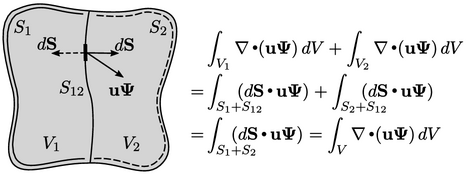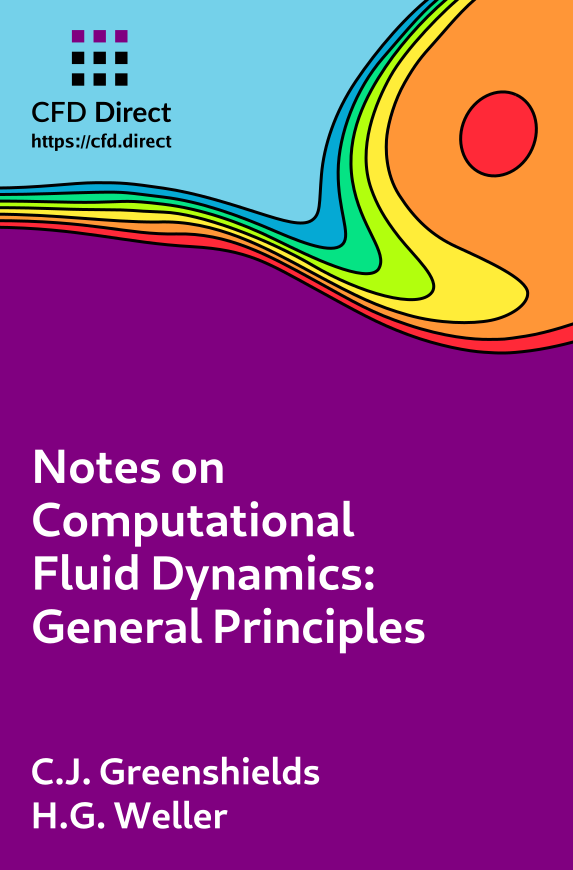2.9 Conservation and boundedness
The material derivative Eq. (2.14
) includes the
 term. However, the term can take for the form
term. However, the term can take for the form  , by applying
conservation of mass Eq. (2.8
), as shown in Sec. 2.8
. The two terms are related by
the product rule
, by applying
conservation of mass Eq. (2.8
), as shown in Sec. 2.8
. The two terms are related by
the product rule
 |
(2.31) |
While the two terms  and
and  appear similar,
they affect the solution of an equation is different ways.
appear similar,
they affect the solution of an equation is different ways.

The  term maintains conservation in
term maintains conservation in  . All variables
are inside (to the right of) the divergence
. All variables
are inside (to the right of) the divergence  , so when we integrate
it over a volume
, so when we integrate
it over a volume  , it can be entirely transformed by Gauss’s
theorem to an integral of the flux of
, it can be entirely transformed by Gauss’s
theorem to an integral of the flux of
 at
at
 .
.
If we split  into two sub-volumes
into two sub-volumes
 and
and
 ,
the surface integrals are also split over two surfaces
,
the surface integrals are also split over two surfaces  and
and
 ,
where
,
where  is the part of the surface common to both volumes.
is the part of the surface common to both volumes.
The fluxes at  for each sub-volume
have equal magnitude but opposite sign, since their respective
surface area vectors
for each sub-volume
have equal magnitude but opposite sign, since their respective
surface area vectors  point outwards from the volume in opposing
directions. These fluxes cancel one another out, such that the sum
of integrals over
point outwards from the volume in opposing
directions. These fluxes cancel one another out, such that the sum
of integrals over  and
and  is identically equal to the integral over
is identically equal to the integral over
 .
.
Thus, the term  ensures conservation in
ensures conservation in
 across a surface separating regions of the flow domain. Conservation
is guaranteed at all points in the limit
across a surface separating regions of the flow domain. Conservation
is guaranteed at all points in the limit  for any sub-volume.
for any sub-volume.
The  form cannot transform to a surface integral so
does not ensure conservation. Instead it ensures boundedness, as demonstrated by
the solution of
form cannot transform to a surface integral so
does not ensure conservation. Instead it ensures boundedness, as demonstrated by
the solution of  in the following equation in one (
in the following equation in one ( ) dimension
(1D)
) dimension
(1D)
 |
(2.32) |
 . If
. If  is uniform, then
the profile of
is uniform, then
the profile of  does not change but simply translates at a speed
does not change but simply translates at a speed
 as
shown in the left diagram. If
as
shown in the left diagram. If  varies with
varies with
 ,
the profile changes, e.g. flattens, as shown in the
right diagram.
,
the profile changes, e.g. flattens, as shown in the
right diagram.

In both cases, the  profile remains within the original bounds of
profile remains within the original bounds of
 and
and
 ;
the solution is said to be bounded. While the behaviour is
illustrated in 1D, it extends to 3D.
;
the solution is said to be bounded. While the behaviour is
illustrated in 1D, it extends to 3D.
Thus, the  term ensures boundedness. By contrast, the
term ensures boundedness. By contrast, the
 term, while ensuring conservation, does not ensure boundedness when
term, while ensuring conservation, does not ensure boundedness when
 .
The two terms are connected by
.
The two terms are connected by  which changes
which changes
 due
to expansion/contraction of the fluid, as discussed in
Sec. 2.4
. Its effect is illustrated by
flattening of the profile in the right diagram, since a non-uniform
due
to expansion/contraction of the fluid, as discussed in
Sec. 2.4
. Its effect is illustrated by
flattening of the profile in the right diagram, since a non-uniform
 corresponds to
corresponds to  .
.

